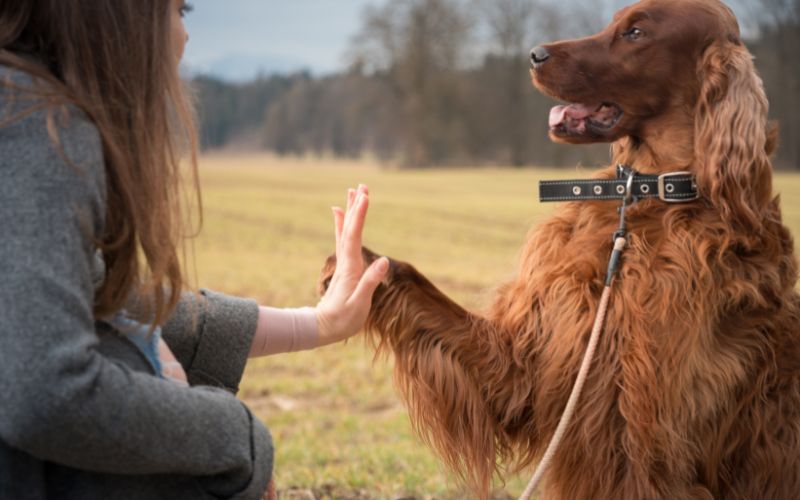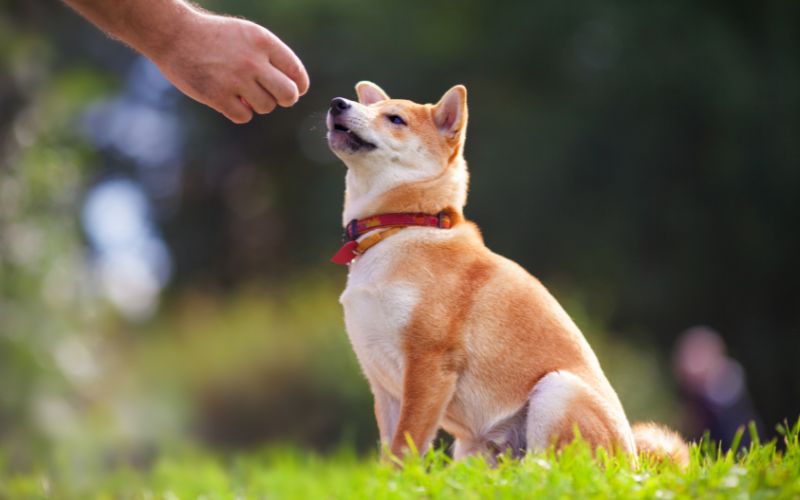Dogs are arguably the best animals to have as pets.
They are loyal, friendly and always happy to see their owners.
One of the key ways to ensure that your dog continues to be a loving and obedient pet is through proper training.
There are many different methods of dog training, but one of the most popular is using treats.
Treat-based training is often seen as being more effective than other methods, but does it really work?
Let’s take a closer look at the pros and cons of treat-based dog training.
Treats are a great asset when training a dog and there is a place for using treats in your dog training schedule. Dogs learn best when they are rewarded with a valuable and substantial reward and a treat is the best option when training a young or inexperienced dog or a dog whose behaviour you are looking to change.
Why do we use treats when dog training?
The main reason why treats are used when dog training is because dogs love food.
Food is a powerful motivator for dogs and it can be a very effective way to get your dog to focus on you and what you are asking them to do.
When using treats as a form of reward, it is important to make sure that the treat is something that your dog really loves and is willing to work for.
If the treat is not something that your dog finds valuable, then they are unlikely to be motivated to do what you are asking of them.
Another reason why treats are used in dog training is because they are an easy and convenient way to reward your dog for good behaviour.
Treats can be given quickly and easily, which means that you can reinforce good behaviour immediately.
This is important because dogs learn best when they are rewarded for good behaviour as soon as possible after they do it.
What are the benefits of using treats when dog training?
There are many benefits to using treats when dog training.
As we have already mentioned, treats are a great way to motivate your dog and get them to focus on you.
Treats are also an easy and convenient way to reward your dog for good behaviour.
Another benefit of using treats when dog training is that it can help to build a bond between you and your dog.
When you give your dog a treat, they will often look to you for approval and this can help to create a strong bond between you and your dog.
Finally, using treats when dog training can also be a great way to keep your dog’s attention.
If you are trying to train your dog to do something specific, such as sit or stay, then it is important to keep their attention on you.
This can be difficult, but if you have a treat in your hand, then it is likely that your dog will focus their attention on you and what you are asking them to do.

Are there any downsides to using treats when dog training?
There are a few potential downsides to using treats when dog training.
The first is that some people believe that using treats can create a dependency in your dog and they may become reliant on being given a treat in order to obey commands.
However, if you are careful to only use treats occasionally and only give them for good behaviour, then this should not be a problem.
Another downside of using treats when dog training is that it can be easy to overdo it.
If you give your dog too many treats, then they may start to expect them all the time and this can lead to problems.
It is important to find a balance and only give your dog treats when they have done something that you have asked of them or when they have behaved in the way that you want them to.
Finally, some people believe that using treats can make dogs fat.
However, as long as you are careful about the type and amount of treat that you give your dog, then this should not be a problem.
There are many low-calorie treats available that are designed specifically for dogs and these can be a great way to reward your dog without making them put on weight.
How to use treats when dog training?
If you want to use treats when dog training, then there are a few things that you need to keep in mind.
First, it is important to make sure that the treat is something that your dog really loves.
If the treat is not something that your dog enjoys, then they are unlikely to be motivated to do what you are asking of them.
As an example of the use of treats for training let’s take the business of getting the dog to come to you when you call his name.
You can do this in the house or in the garden, just make sure that there are no distractions.
As your dog is sniffing around, call his name to get his attention and encourage him to come to you.
As soon as he gets to you give him his treat and tell him what a great dog he is.
It’s important that you give him the treat immediately that he gets to you. Don’t try to make him sit down or mess around waiting.
By giving him the treat straightaway he will associate the act of returning to you with the treat.
Once he has had the treat, let him play again.
From your dog’s perspective he gets to play, gets a treat from the human when his name is called and then is allowed to play again – great.
You will need to repeat this exercise regularly, using the treat as a reward when he returns.
The use of the treat uses the same reward principle as when we teach a dog to sit – which you can read about here.
Isn’t using treats bribing the dog?
Many people adopt the approach that using treats is bribing the dog.
But this is not true.
A treat should be given as a reward for good behaviour and not as a bribe to make the dog do something that he doesn’t want to do and, when used properly treats will generate excellent results in dogs.
Consider this in a human environment. If your boss asked you to work 4 hours overtime then you’d probably do it.
The extra money would be useful perhaps?
Now, if at the end of the shift your boss said “Good human” and patted you on the head, you’d feel a little fed up and it’s unlikely that you’d help him out again.
Now, if he paid you straightaway for the extra hours and you saw the benefit of your efforts, then you’ll be more likely to help in the future.
It’s the same for your dog. If there’s no benefit to him then why would he listen.
Try it.
In a nutshell using treats for dog training
Pros:
Treats can be a great motivator for your dog.
If you want your dog to learn a new trick or behavior, then using treats as a reward can be a great way to get them to do it.
Treats can also help to build a bond between you and your dog.
When you’re constantly giving your dog treats, they’ll start to see you as someone who is always there for them and someone who they can trust.
Treats can also be used as a way to calm your dog down.
If your dog is feeling anxious or stressed, then giving them a treat can help to take the edge off and make them feel more relaxed.
Cons:
Treats should not be used as the only form of reward for your dog.
If you only give your dog treats when they do something, then they’re going to start to expect treats all the time. This can lead to them becoming spoiled and demanding.
Treats can also cause your dog to become overweight.
If you’re constantly giving your dog treats, then they’re going to consume more calories than they’re burning. This can lead to weight gain and obesity, which can be harmful to your dog’s health.
Treats can also create a dependence on them.
If your dog is only motivated by treats, then they’re going to be less likely to listen to you when there are no treats around. This can make training more difficult and can lead to a dependence on treats.
Final Words
Using treats for dog training can be a great way to motivate your dog and get them to do what you want.
However, it’s important to use treats in moderation and to ensure that they’re not the only form of reward.
Treats should be used as a way to supplement other forms of reward, such as petting, praise, and attention.
If you use treats properly, then they can be a great tool for dog training. However, if you abuse them, then they can cause more harm than good.
Remember that every dog is different, so what works for one dog might not work for another.
It’s important to experiment and find what works best for your dog.










